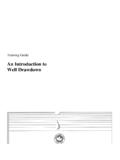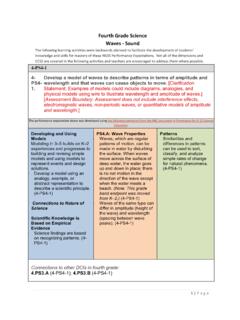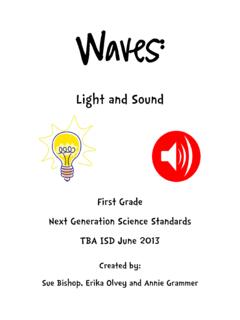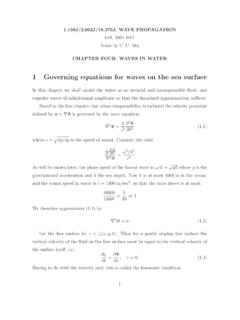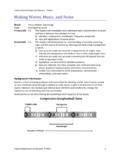Transcription of Making Waves - VDOE
1 Science Enhanced Scope and Sequence Grade 5 virginia department of education 2012 1 Making Waves Strand Force, Motion, and Energy Topic Investigating sound Primary SOL The student will investigate and understand basic characteristics of sound and how it behaves. Key concepts include a) compression Waves ; b) vibrations, compression, wavelength, frequency, amplitude; d) uses and applications of sound Waves . Relaed SOL The student will demonstrate an understanding of scientific reasoning, logic, and the nature of science by planning and conducting investigations in which h) predictions are made using patterns from data collected, and simple graphical data are generated; i) inferences are made and conclusions are drawn; j) models are constructed to clarify explanations, demonstrate relationships, and solve needs; k) current applications are used to reinforce science concepts. Background Information sound is a form of energy produced and transmitted by vibrating matter.
2 sound Waves caused by such vibrations move through a medium (a solid, liquid, or gas) in all directions from their source. However, the medium just vibrates back and forth and transfers the energy; the medium is not carried along with the sound wave. sound Waves can be described by the wavelength and frequency of the Waves . sound travels more quickly through solids than through liquids and gases because the molecules of a solid are closer together and can transmit the vibrations (energy) faster. sound Science Enhanced Scope and Sequence Grade 5 virginia department of education 2012 2 travels most slowly through gases because the molecules of a gas are farthest apart. Some animals make and hear frequencies of sound vibrations (pitches) that humans cannot make nor hear. Musical instruments vibrate to produce sound . Remind children that sound travels slower than light, which is why they'll usually see a flash of lightening before they hear the crack of thunder; both happen at the same time, but light reaches us before the sound does.
3 Musical instruments vibrate to produce sound . There are many different types of musical instruments and each instrument causes the vibrations in different ways. Stringed instruments produce sound when their strings are caused to vibrate. The strings can be plucked, bowed or struck, depending upon the instrument. A percussion instrument is any instrument whose sound is generated by striking, rubbing, shaking or otherwise impacting a surface to create audible vibrations. The bigger a percussion instrument is, the lower its pitch. Any instrument that produces sound from having air blown into it or across it can be considered a wind instrument. Materials Speaker with removable cover Walking spring toy Pictures of various musical instruments including string, percussion, and wind instruments A variety of supplies for the construction of musical instruments by each team ( , shoe boxes with lids, string, rubber bands, paper clips, pipe cleaners, straws, fishing line, bottles and water, paper plates, empty oatmeal or cornstarch containers, sticks made from dowel, old hose, funnels, etc.)
4 Student journals Vocabulary wave, frequency, vibrations, pitch, sound , wavelength, refraction, energy, string instrument, percussion instrument, wind instrument Student/Teacher Actions (what students and teachers should be doing to facilitate learning) Introduction 1. Ask the students whether they have ever felt a sound wave. o They have heard sounds, of course, but how about feeling sounds? If they have ever been next to a speaker with very loud bass tones being emitted, such as those in some cars, then it is likely they have. o Could a person who is deaf or hearing impaired feel a sound ? 2. Have students discuss experiences at a concert, an amphitheater, a movie, or any other place near a vibrating speaker. 3. Show the students a loudspeaker with the cover removed. Science Enhanced Scope and Sequence Grade 5 virginia department of education 2012 3 4. Explain that the speaker is made up of two main parts: the tweeter and the woofer.
5 Ask why they think these names were used to name these parts. (The tweeter makes the higher pitched sounds and the woofer makes the lower pitched sounds. They do this by moving a membrane back and forth, in and out, to push the air and make it vibrate.) 5. If the speaker can be connected to a CD player, play some music, and let the students watch the membranes moving. 6. Take the class outside to the playground or an area around the school. Have the students bring their science journals. 7. Ask them to sit as quietly as they can and listen to their surroundings. (You may want them to close their eyes to help them concentrate.) 8. Have the students write down the sounds that they hear. 9. When you return to the classroom, have the students put an L by the sounds they heard which were loud and a Q by the sounds that were quiet. Also have them write an H by the sounds they heard that were high pitched and a W by the sounds which were low pitched.
6 Have your students share their findings with the class. You can write the sounds on the board or on a chart, and build a graph of what was heard. Procedure Activity 1 Modeling a Compression Wave (1) 1. Model a sound wave by stretching out a walking spring toy on a table or desk. Hold one end, and have a student hold the other. Give your end of the walking spring toy a pulse by pushing it forward a little very quickly and immediately pulling it back to the starting position. 2. Ask students to identify where the compressed coils are, and identify those areas as the compression wave that move down the walking spring toy from one end to the other. 3. Explain that this model looks like the movement of a compression wave or sound wave. Your hand is acting like the speaker diaphragm that makes the air vibrate. Activity 2 Modeling a Compression Wave (2) 4. For this demonstration make sure students will be able to have some room to move. 5.
7 Have most of the students stand in a row at one side of the classroom, facing out into the classroom. Let some of the students stand across the room from the line so that they can see the " Waves ." 6. Starting with the student at one of the lines, have the line make a compression wave. 7. Have the students start with their arms out straight in front of them. As the wave goes by, each student will swing both arms first toward, and then away, from the next student in line. 8. Let the students take turns being the first in line, being in line, and watching the line from the other side of the room. Activity 3 Classroom Musical Group 1. Divide the class into three groups. 2. Give one group pictures of stringed instruments ( , guitar, violin, harp, piano, etc.), one group pictures of percussion instruments ( , drum, cymbals, bells, etc.), and one group pictures of wind instruments ( , flute, clarinet, trombone, French horn, harmonica, etc.).
8 Have the groups conduct research about the kinds of instruments that Science Enhanced Scope and Sequence Grade 5 virginia department of education 2012 4 are in the pictures and how those kind of instruments produce sound (how they produce vibrations). 3. Have each group tell the class about their instruments. 4. Tell the students that they are going to work in pairs to create a musical instrument. The pairs should each be assigned a particular kind of instrument (stringed, percussion, or wind) that they will make. You can assign the instrument that each team will make in a variety of ways. You can have them make the kind of instrument they explored with the pictures or you can put the words string, percussion, and wind on small strips of paper and have each team draw a type of instrument to make. 5. Once each team knows which kind of instrument they are going to make, give them the activity sheet for their instrument. Set out the various supplies you have gathered for them to select to use, and have them follow the instructions on their activity sheet.
9 Conclusion 1. Have each pair display their instrument, demonstrate how it works, and explain how it makes sound . 2. Have all the pairs play the song Mary Had a Little Lamb with their instruments together as a musical group. Do this several times so that every student has the opportunity to actually play their instrument. 3. Hold a class discussion on what the students have seen in the demonstrations and with their instruments. Make certain that students understand that when a sound wave travels through a medium, individual molecules of the medium (air, water, solid) do not change location; they just vibrate back and forth, transferring the vibration from one molecule to the next to the next: energy, not matter, is transferred. Put another way, sound Waves are energy moving from one place to another through a medium, but the molecules of the medium ( , the air or water molecules) do not move with the wave but merely vibrate to transfer the energy along.
10 Assessment Questions o What is sound ? o How is sound made? o How does sound travel? o Explain how a stringed instrument produces sound . o Explain how a percussion instrument produces sound . o Explain how a wind instrument produces sound . Journal/writing prompts o Draw a compression wave and label the parts of the wave. Other o Compare the compression and rarefaction parts on a sound wave. Extensions and Connections (for all students) Have students draw a diagram of what happens in the air when a sound wave travels from a sound source to their ear. Drawings should include the source of the vibrations, an accurate illustration of the vibrations, and an ear. Science Enhanced Scope and Sequence Grade 5 virginia department of education 2012 5 Have student conduct research about unusual musical instruments or historical musical instruments. Have the students play a variety of tunes with their musical instruments ( , Row, Row, Row Your Boat, If You re Happy and You Know It, etc.)










